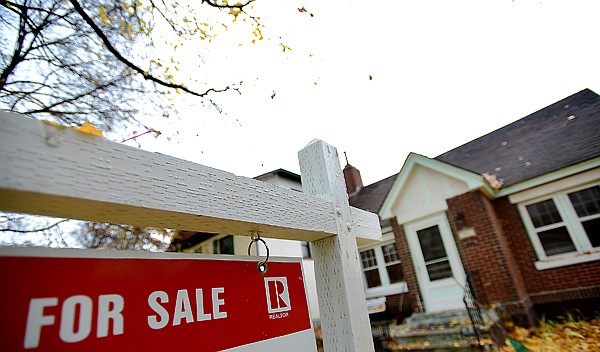Real estate market turns a corner
Though Flathead Valley real estate prices may be rising only slightly, the number of real estate transactions has gone up dramatically.
“Everything is selling more, at least in my sector,” said David Fetveit, a broker with Trails West Real Estate. “There’s an uptick in commercial, an uptick in land, people who want to build now, people who want to build later, primary homes, vacation homes, retirees — it’s across the board.”
According to Northwest Montana Multiple Listing Service figures, there have been more than $50 million a month in gross real estate sales over the last six months.
Numbers compiled by Jim Kelley of Kelley Appraisal in Kalispell show the 1,002 overall residential sales from January through September outpacing the previous year’s 777 sales in the same period, an increase of 29 percent.
The year 2006 was the recent high mark in sales activity for the same period, with 1,429 sales from January through September, dropping to 1,085 sales in 2007. This hit bottom in 2009 with 614 transactions.
Median and average prices were up very slightly in 2012 from 2011, with the median in 2012 up by 0.6 percent and the average increasing 3.9 percent.
But the market is changing in a big way, Fetveit said.
“We hadn’t seen $50 million in any given month all the way back to October of 2008,” Fetveit said.
Multiple Listing Service data show a total sales volume of $69 million for September alone, the highest single month since October 2007.
“The good news is that there are signs that we are starting the healing process,” said Doug Denmark, owner of RE/MAX Glacier Country in Kalispell.
Fetveit is encouraged by the strength of the September numbers.
“I think we were all a little surprised about how September really took off,” Fetveit said. “It really capped the third quarter and made for big numbers. I think we were all expecting things to keep the status quo until the elections were over.”
Doug Zignego, a broker with Dean & Leininger in Kalispell and president of the Northwest Montana Multiple Listing Service, sees a number of reasons for the boost in sales; he expects the trend to continue.
“A lot of it is driven by the foreclosure market. There are some good deals and good value out there,” he said. “The interest rates are incredibly low — it’s a perfect time to invest.”
Denmark, who has been in real estate for 31 years and has seen four full market cycles, said that getting foreclosures pushed through the market is the first step before prices adjust upward.
“We are working through the foreclosures and distressed properties more rapidly,” he said. “We’re hearing from banks that we work with that it’s starting to taper off to a fairly low level of foreclosures. And they’re selling faster and typically selling for the full price.”
Selling off the foreclosures is good news for everyone, Denmark said. He said foreclosed properties tend to dominate the sales out of proportion to availability because everyone wants a bargain.
“When you go to a big sale, you ignore the rest of the store,” he said. “That’s the reality we face.”
Kelley agrees that the past poor market is allowing for some of the new activity.
“There are currently a lot of bank-owned and distressed properties on the market, and as that inventory starts to deplete, we’re likely to see stronger prices,” he said. “The price picture is likely to improve as demand continues.”
According to Kelley Appraisal compilations, bank-owned sales make up a substantial portion of the recent market activity, with 313 units selling from January to September 2012, making up 31 percent of the market. The median price for those is $150,000.
Distressed-property listings are dropping, with 122 foreclosures on the market in the third quarter of 2012, down from 143 in the third quarter a year ago.
Zignego said there are some segments of the market, such as the homes priced at $150,000 or less, in which the inventory supply eventually will fall substantially due to strong demand. However, other segments still carry a longer inventory based on the current absorption rate.
“I really believe that we have reached the bottom and are coming back out,” Zignego said. “One thing that works against us is the inventory we have. We see some prices firming up in the more solid subdivisions that are well established and don’t have a lot of turnover, but by any definition, it’s still a buyers’ market.”
Fetveit said he believes that the overall economic mood has shifted. People are expecting prices in the real estate market to only go up from here, he said.
“Overall it’s people’s mentality and their perspective,” he said. “Buying real estate is just like any other investment. You don’t want to lose money. There’s enough positive momentum that now the perception has shifted to people being worried about missing out. People are making sure they’re getting deals while they can.”
He theorizes that people might see prices rising in feeder markets, such as a 1.8 percent increase in real estate prices in Phoenix in August, for example, and jump to get in on the market before that trend hits locally.
Zignego said he believes that sales would be moving at an even faster rate if loan qualification standards were not so tight. He said buyers are often kicked out of the process after they’ve already made plans to take possession of a house under contract, which creates market frustration.
“Things will be going along smoothly, and some little hiccup will happen,” he said. “Someone changes jobs or buys a truck, and all of a sudden, the lender decides they won’t finance.”
He advises buyers to work with lenders up front and know the limits of their purchasing ability before they embark on a property search.
Business reporter Heidi Gaiser may be reached at 758-4439 or by email at hgaiser@dailyinterlake.com.

